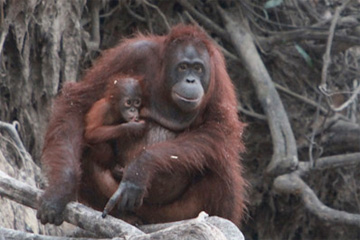|
|
Orangutan encounter rates have fallen six-fold in Borneo over the past 150 years, report researchers writing in the journal PLoS One.
Erik Meijaard, an ecologist with People and Nature Consulting International, and colleagues compared present-day encounter rates with collection rates from naturalists working in the mid-19th Century. They found orangutans are much rarer today even in pristine forest areas.
“Whereas some early explorers would see as many as eight orangutans in one tree or encounter three dozen along a river in a single day, today, in the same forests, spotting orangutan in the wild is rare,” Meijaard told mongabay.com via email.
 Sumatran orangutan |
The results suggest hunting is taking a toll on orangutan populations.
“Recent interviews of nearly 7000 villagers in Kalimantan [the Indonesian part of Borneo] revealed that over a thousand orangutans are still killed annually by local people, of which more than 50% is for food,” he said.
Meijaard and his co-authors highlight several factors that may have led to an increase in hunting in Borneo, including a particularly unusual one for Northern Borneo: a ban on head-hunting by colonial rulers in Malaysia.
“It remains unclear why hunting pressure would have increased in western Sabah a few hundred years ago. The timing coincides with the approximate end of head-hunting in Borneo, which had kept large parts of the island too dangerous to travel in,” the authors write. “Banks inferred that head-hunting provided wildlife a refuge, because large areas of forest were avoided by hunters fearful of roving bands of head-hunters. He noted that, immediately after the colonial ban on head-hunting was enforced, many forest areas became much safer to travel through, allowing hunters to travel further from villages… Also, it has been suggested that orangutan heads replaced human heads as trophies, which may also have added to hunting pressure on orangutans.”
 Borneo orangutan |
Looking at data from Indonesian Borneo, the researchers note a correlation between orangutan densities and the distance from villages: more remote forest areas have more orangutans.
The authors write that introduced disease could also be a factor in the apparent decline in orangutan populations, but note there is no evidence to date of epidemics in wild orangutans.
Danger of shifting baselines
The finding that orangutan densities were once considerably higher leads the authors to warn that the present state of knowledge on the red apes may be biased by a “shifting baseline” scenario: a situation where current degraded conditions are assumed to be the representative of past conditions.
“Insights from our study make us realize how much the population baseline may have shifted,” Meijaard told mongabay.com via email. “There may have been half a million orangutans 150 years ago, and even more before that.”
“Scientists have learned about orangutans by studying them under present-day conditions and densities, but this might be a bit like studying bushmen in the Kalahari to understand the behavior of a New Yorker.”
In other words, everything we think we know about orangutans may be based on incomplete knowledge.
“If our ideas turn out to be correct it would completely change the way we understand breeding, interactions between sexes, feeding habits, and ranging,” he said, adding that conservationists will need to consider these issues in their strategies to protect orangutans, which currently number around 50,000 between populations in Sumatra and Borneo.
 Kalimantan, 2006  Kalimantan, 2009 |
“Conservation won’t get us back to the half million orangutans of [19th century biologist Alfred] Wallace’s day, but what should we be aiming for?”
Meijaard says the research also highlights the need to more effectively address hunting as a major threats to orangutans.
“The present study and another one that we still need to publish increasingly indicate that hunting by local people has been and still is a massive threat to orangutans in Kalimantan. Not a single program is addressing that issue though. Why? Is it too sensitive to blame poor Dayaks? Or is it too difficult? Whichever the reason, it is obvious that unless we can address hunting, pretty much all of Kalimantan’s orangutans that occur outside protected areas are doomed.”
CITATION: Erik Meijaard, Alan Welsh, Marc Ancrenaz, Serge Wich, Vincent Nijman, Andrew J. Marshall. Declining Orangutan Encounter Rates from Wallace to the Present Suggest the Species Was Once More Abundant. PLoS ONE August 11, 2010
Related articles

(07/29/2010) Many of the environmental issues facing Indonesia are embodied in the plight of the orangutan, the red ape that inhabits the islands of Borneo and Sumatra. Orangutan populations have plummeted over the past century, a result of hunting, habitat loss, the pet trade, and human-ape conflict. Accordingly, governments, charities, and concerned individuals have ploughed tens of millions of dollars into orangutan conservation, but have little to show in terms of slowing or reversing the decline. The same can be said about forest conservation in Indonesia: while massive amounts of money have been put toward protecting and sustainable using forests, the sum is dwarfed by the returns from converting forests into timber, rice, paper, and palm oil. So orangutans—and forests—continue to lose out to economic development, at least as conventionally pursued. Poor governance means that even when well-intentioned measures are in place, they are often undermined by corruption, apathy, or poorly-designed policies. So is there a future for Indonesia’s red apes and their forest home? Erik Meijaard, an ecologist who has worked in Indonesia since 1993 and is considered a world authority on orangutan populations, is cautiously optimistic, although he sees no ‘silver bullet’ solutions.
Rehabilitation not enough to solve orangutan crisis in Indonesia

(08/20/2009) A baby orangutan ambles across the grass at the Borneo Orangutan Survival Foundation’s Nyaru Menteng rehabilitation center in Central Kalimantan, in the heart of Indonesian Borneo. The ape pauses, picks up a stick and makes his way over to a plastic log, lined with small holes. Breaking the stick in two, he pokes one end into a hole in an effort to extract honey that has been deposited by a conservation worker. His expression shows the tool’s use has been fruitful. But he is not alone. To his right another orangutan has turned half a coconut shell into a helmet, two others wrestle on the lawn, and another youngster scales a papaya tree. There are dozens of orangutans, all of which are about the same age. Just outside the compound, dozens of younger orangutans are getting climbing lessons from the Borneo Orangutan Survival Foundation (BOS) staff, while still younger orangutans are being fed milk from bottles in a nearby nursery. Still more orangutans—teenagers and adults—can be found on “Orangutan Island” beyond the center’s main grounds. Meanwhile several recently wild orangutans sit in cages. This is a waiting game. BOS hopes to eventually release all of these orangutans back into their natural habitat—the majestic rainforests and swampy peatlands of Central Kalimantan, on the island of Borneo. But for many, this is a fate that may never be realized.